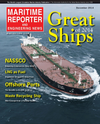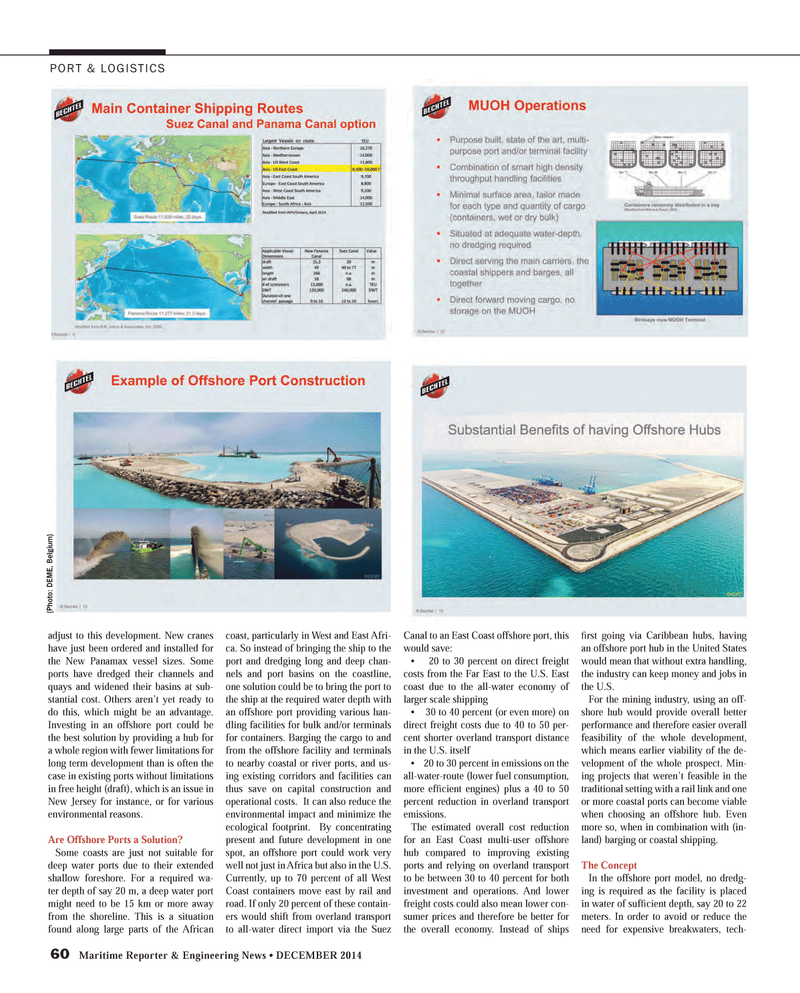
Page 60: of Maritime Reporter Magazine (December 2014)
Great Ships of 2014
Read this page in Pdf, Flash or Html5 edition of December 2014 Maritime Reporter Magazine
60 Maritime Reporter & Engineering News • DECEMBER 2014
PORT & LOGISTICS adjust to this development. New cranes have just been ordered and installed for the New Panamax vessel sizes. Some ports have dredged their channels and quays and widened their basins at sub- stantial cost. Others aren’t yet ready to do this, which might be an advantage.
Investing in an offshore port could be the best solution by providing a hub for a whole region with fewer limitations for long term development than is often the case in existing ports without limitations in free height (draft), which is an issue in
New Jersey for instance, or for various environmental reasons.
Are Offshore Ports a Solution?
Some coasts are just not suitable for deep water ports due to their extended shallow foreshore. For a required wa- ter depth of say 20 m, a deep water port might need to be 15 km or more away from the shoreline. This is a situation found along large parts of the African coast, particularly in West and East Afri- ca. So instead of bringing the ship to the port and dredging long and deep chan- nels and port basins on the coastline, one solution could be to bring the port to the ship at the required water depth with an offshore port providing various han- dling facilities for bulk and/or terminals for containers. Barging the cargo to and from the offshore facility and terminals to nearby coastal or river ports, and us- ing existing corridors and facilities can thus save on capital construction and operational costs. It can also reduce the environmental impact and minimize the ecological footprint. By concentrating present and future development in one spot, an offshore port could work very well not just in Africa but also in the U.S.
Currently, up to 70 percent of all West
Coast containers move east by rail and road. If only 20 percent of these contain- ers would shift from overland transport to all-water direct import via the Suez
Canal to an East Coast offshore port, this would save: • 20 to 30 percent on direct freight costs from the Far East to the U.S. East coast due to the all-water economy of larger scale shipping • 30 to 40 percent (or even more) on direct freight costs due to 40 to 50 per- cent shorter overland transport distance in the U.S. itself • 20 to 30 percent in emissions on the all-water-route (lower fuel consumption, more effi cient engines) plus a 40 to 50 percent reduction in overland transport emissions.
The estimated overall cost reduction for an East Coast multi-user offshore hub compared to improving existing ports and relying on overland transport to be between 30 to 40 percent for both investment and operations. And lower freight costs could also mean lower con- sumer prices and therefore be better for the overall economy. Instead of ships fi rst going via Caribbean hubs, having an offshore port hub in the United States would mean that without extra handling, the industry can keep money and jobs in the U.S.
For the mining industry, using an off- shore hub would provide overall better performance and therefore easier overall feasibility of the whole development, which means earlier viability of the de- velopment of the whole prospect. Min- ing projects that weren’t feasible in the traditional setting with a rail link and one or more coastal ports can become viable when choosing an offshore hub. Even more so, when in combination with (in- land) barging or coastal shipping.
The Concept
In the offshore port model, no dredg- ing is required as the facility is placed in water of suffi cient depth, say 20 to 22 meters. In order to avoid or reduce the need for expensive breakwaters, tech- (Photo: DEME, Belgium)
MR #12 (58-65).indd 60 12/2/2014 2:37:01 PM

 59
59

 61
61
